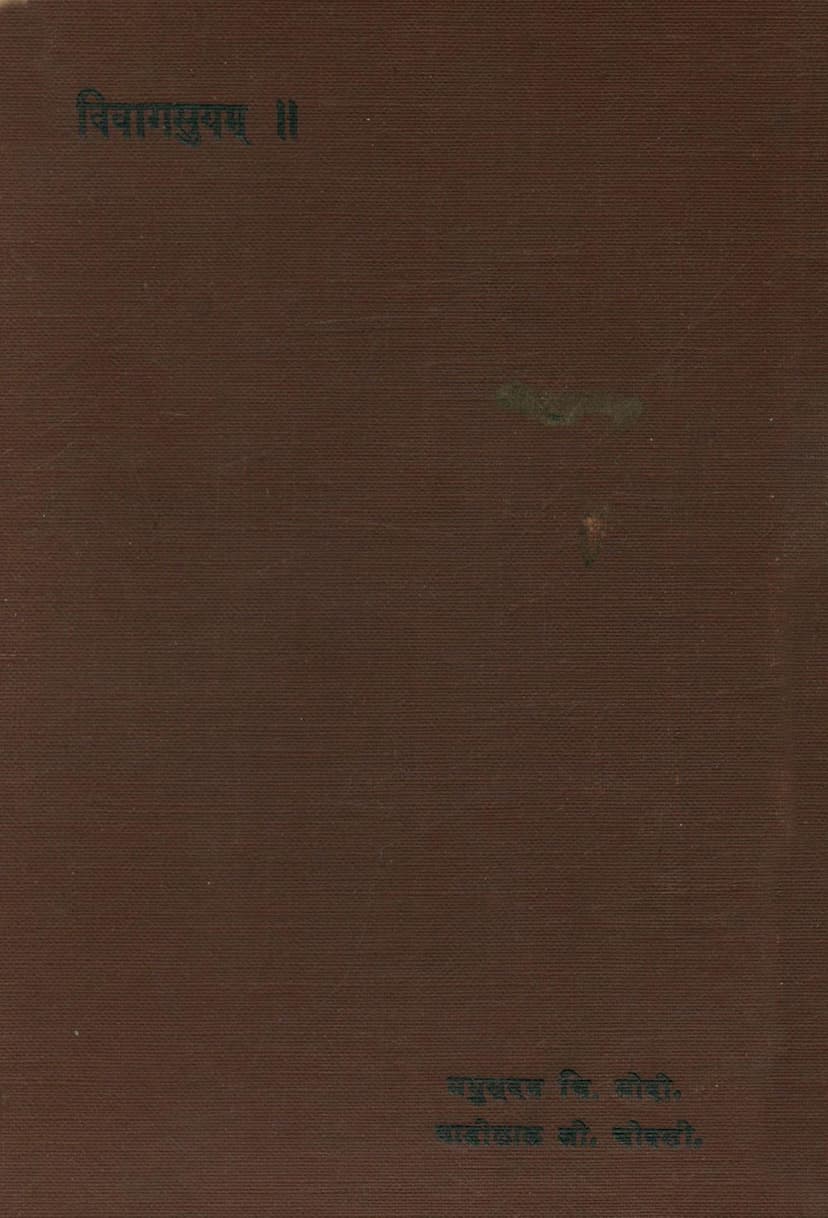Vivagsuyam
Added to library: September 2, 2025

Summary
The provided text is the "Vivāgasuyam," the eleventh Anga of the Jain Canon, edited and translated by V. J. Chokshi and M. C. Modi. This comprehensive work includes the original Prakrit text, an English translation, notes, a glossary, and Abhayadeva's commentary.
Book Title: Vivāgasuyam (The Eleventh Anga of the Jain Canon) Author(s): Madhusudan Modi (as editor/commentator), with V. J. Chokshi. Publisher: Gurjar Granth Ratna Karyalay, Ahmedabad. Foreword: The foreword by K. V. Abhyankar, Professor of Sanskrit and Ardha-Magadhi, Gujarat College, praises the edition for its utility to university students, noting its clarity, lucidity, and accurate representation of the original Prakrit text.
Introduction Summary:
The introduction explains that the current form of the Jain Canon belongs to the Svetambara tradition and was redacted by Devardhi-ganin Kshamasramana in 513 AD. The Jain canon consists of 45 scriptures, including 11 Anga Sutras, of which Vivāgasuyam is the eleventh. Originally there were 12 Angas, but the last, Ditthivaya, was lost.
Vivāgasuyam Structure:
The Vivāgasuyam is divided into two books:
-
Book I: Duhavivaga (Fruits of Bad Acts):
- Contains ten lectures, each illustrating moral lessons through stories.
- Lecture 1 (Miyāputta): Focuses on the sin of tyrannical governance, heavy taxation, and ignoring subjects' pleas, leading to hell. It also touches upon ancient medical knowledge and the ineffectiveness of medicine against sins. The episode of the blind man teaches contentment.
- Lecture 2 (Ujziyaya): Condemns torturing animals, eating their flesh, and drinking wine as grave sins leading to dire consequences. It offers insights into ancient customs like public announcements of offenders and highlights the sins of addiction to harlots, sensual pleasures, gambling, and other vices. It also provides legal information regarding courtesans.
- Lecture 3 (Abhaggasena): Discusses the sin of destroying and selling bird eggs, leading to punishment. It provides information about settlements of thieves and barbarous ancient penal laws, including gruesome executions. It also illustrates how wine intoxication can lead to ruin.
- Lecture 4 (Sagada): Emphasizes the evil fruits of eating flesh and incestuous sexual relations. It reiterates the ruin caused by addiction to harlots and details a barbaric execution method involving embracing a red-hot iron statue. It also corroborates legal information from Lecture 2.
- Lecture 5: Covers the evil fruits of human sacrifice and adultery, noting Mahavira's opposition to human sacrifice.
- Lecture 6: Focuses on the negative consequences of a jailor tyrannizing offenders, describing cruel punishments and weapons used in ancient times. It also highlights the evil fruits of greed for kingdoms, even at the cost of one's father's life.
- Lecture 7: Further emphasizes the evil fruits of eating flesh, even for medicinal purposes. It mentions the ancient superstitious custom of women propitiating deities for offspring.
- Lecture 8: Reinforces the evil fruits of eating flesh, particularly fish, suggesting it might be for those who consider fish-eating less harmful than other meat.
- Lecture 9 (Devadatta): Portrays the human world driven by passions and sins like murder, detailing intrigues fueled by lust. It highlights women's intrigues and also presents a positive aspect: the importance of devotion to mothers.
- Lecture 10: Primarily reiterates points from previous lectures, emphasizing the pains of a courtesan's life and the incurability of diseases resulting from such sinful acts.
Overall Theme of Book I: The lectures in the first book have an optimistic undertone, serving as guidance for even the most sinful, showing that by suffering for evil deeds and making amends, one can achieve salvation through religion and monkhood.
-
Book II: Suhavivaga (Fruits of Good Acts):
- Also contains ten lectures.
- Illustrates the importance of religion and monkhood, presenting righteous lives.
- Lecture 1 (Subahu): Details Subahu's life of religion and monkhood, emphasizing the importance of giving pure alms with pure intention. It states that the combination of pure alms, a worthy donor, and a worthy recipient leads to bliss, divine favor, and final beatitude.
- The remaining nine lectures are similar in structure, with variations in names and places, illustrating the benefits of righteous living and adherence to religious principles.
Narrative Style: The text notes that the descriptions and plots are repetitive, relying on similar patterns and requiring readers to infer details from other sutras or previous narratives within the same sutra. Some stories are described as repulsive, contributing to an atmosphere of gloom and cynicism, possibly to instill aversion to worldly life and highlight the sorrowful consequences of evil actions.
Editorial Information: The text is based on the Agamodaya Samiti edition, with consultation of a manuscript from Bhavanagar and Dr. P. L. Vaidya's edition. The publication aims to meet the needs of students and the general public interested in Jain texts.
In essence, the Vivāgasuyam serves as a detailed exposition of the karmic consequences of actions, both good and bad, within the framework of Jain philosophy, offering moral guidance and illustrating the path to liberation through righteous conduct and spiritual discipline.